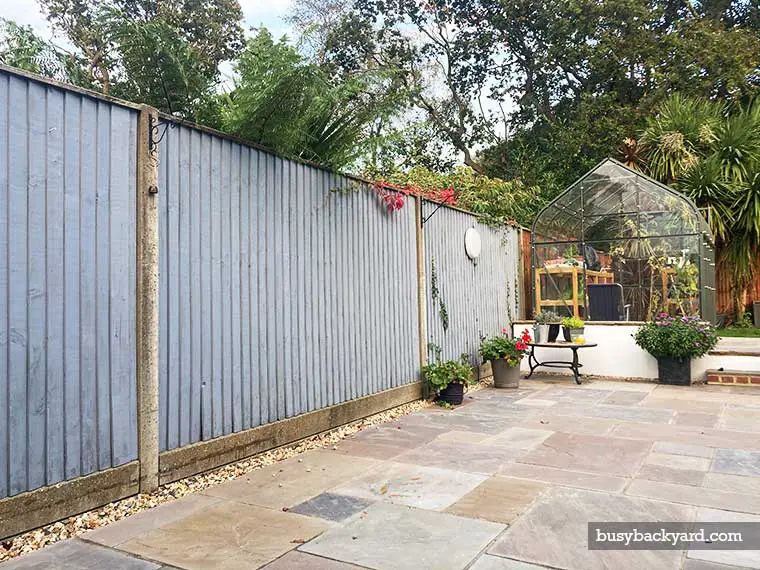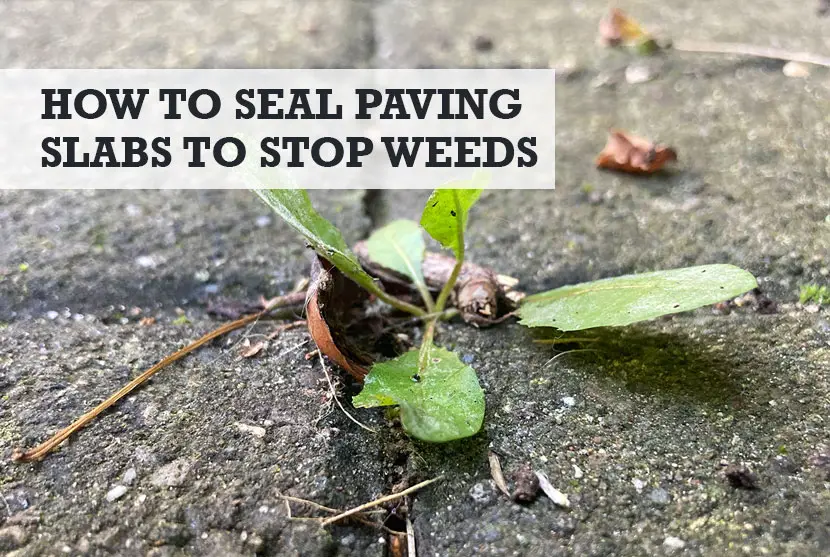There’s nothing more frustrating that seeing weeds growing between your pavers. It’s a such a tough job to remove them so better to stop it happening in the first place. Here’s the easy and simple way you can seal your block paving to stop the weeds.
How to seal pavers to prevent weeds
Whether you have new blocks or old ones with weeds growing through them already, it’s possible to seal them so no more weeds invade your space. Before you get started, here’s what you will need to seal your pavers.
What you will need
- Jointing sand (view on Amazon)
- Paver sealant (view on Amazon)
- Pressure washer
- Brush
How to seal block paving to stop weeds
1. Remove all the weeds and clean out debris
Before you seal the block paving slabs you need to get rid of any weeds that are growing between the pavers. This involves de-weeding and cleaning any debris and dirt out for a thorough clean.
If you don’t, it’s possible for the weeds to grow back through again. I will assume you’ve already done this, but if you haven’t, there are some quick instructions lower down the page.
Once the gaps between the pavers are completely clean and free of weeds and dirt, you can start the process of sealing block paving to stop weeds and described in point 2.
2. Push joint sand into the gaps
The joint sand is what acts as a binding agent and fills in small gaps between your block paving slabs (I use this from Amazon). Before applying joint sand, make sure there’s no water on your block paving slabs. Brush any water away with a broom to get rid of any excess liquid.
Next, wet the gaps and joints a little, and then apply the jointing sand by pouring it and then brushing it into the gaps. Once the gaps are filled with sand, you can use the broom again to sweep away excess sand which has spilled over the edges or hasn’t been pushed into the joins.
You don’t want the sand to overflow or come up higher than the joints. You can now move on to sealing the block paving to stop the weeds – and I recommend you do this on the same day.
3. Applying the sealant to seal the gaps (in dry weather)
Before applying an appropriate sealant (view on Amazon), ensure that the slabs are clean of any debris. You should also check the weather and whether there are any instructions relating to rain. Sealants should not be applied in wet weather – it needs to be done in dry weather conditions.
The temperature can also play a part. The best temperature to seal pavers to prevent weeds is 5°c – 20°c (41 to 68 Fahrenheit).
Most paving sealants are safe and non-toxic as they don’t contain solvents. However, do check because if yours do, you should wear safety goggles and gloves. Check the label before proceeding.
I also recommend you test a small area of your pavers first. You want to make sure it doesn’t dry in a colour or shade you were not expecting.
You can then seal the block paving slabs to prevent the weeds.
- The first coat for sealant is for impregnation and will apply the first level to the block paving slabs.
- I recommend using either a fibre brush, paint pad or sponge to saturate the block paving slabs. However, make your life easier by using low-pressure sprayer that will apply an even finish.
- Many sealers should be applied at a ratio of 150 ml per metre squared. Check the label though before you start.
- If using a low-pressure sprayer, I recommend applying the patio sealant in circular and consistent motions, going slab by slab, whilst paying attention to which parts you have sprayed each time.
- After 10 minutes, check that the sealant application has evenly covered the block paving slabs, making sure that the sealer has distributed evenly to allow for a full, and even absorption.
Once that is done, apply a second coat of sealant using the same process.
Many modern sealers that stop weeds in patios and pavers take up to 3 hours to dry. I recommend you leave overnight though before stepping on it.
Now, that’s how you successfully seal block paving to stop weeds, but what about the initial clean – here’s how you do that part.
Cleaning the block pavers of weeds
1. Kill and remove any weeds
You can use a weed killer for this purpose. Spray the product on the weeds until they wither away and die. Make sure that chemicals do not meet surrounding plants or grass. After the weeds die, remove them using a small brush and put them in the bin bag.

It is important to take away all dead plants because they can act as food for other weeds further down the line. Wait until all the weeds have died before you move on to the next step.
2. Removing debris using a pressure washer
Pressure wash away anything left. It’s a dirty job but needs to be done. Place the nozzle of the pressure washer on one edge of your block paving slabs and ensure that it creates a mist over the entire section. Work backwards until all areas are treated with degreasing solution.
After working in sections, you can need to get rid of all spray with a squeegee. Cleaning up the excess water with the squeegee is essential because it prevents you from accidentally pushing water into joints which can cause discolouration or freezing when temperatures drop in winter.
Does sealing block paving stop weeds?
Yes, by sealing your block paving it will prevent and stop weeds growing through or into the gaps. Sealing the patio pavers will also help maintain the original colour of the stones and stop the sun’s UV rays from fading them.
However, even the best block paving sealant will only last a couple of years, so repeat the process every 24 months to stop the weeds growing through your block paving slabs.
What to put between block paving to stop weeds?
As shown in my guide to sealing pavers against weed growth, the best thing to put between block paving is a quality jointing sand. Push it into the gaps, then seal the pavers with a good sealant.

Conclusion
Block paving slabs are often used on driveways, patios, and other outdoor areas. They are inexpensive to buy, easy to install and require little maintenance.
However, one downside is that they can be porous, which means weeds grow through the gaps between the slabs.
But, if you follow the steps above, you will very quickly stop and prevent weeds growing in the gaps and joints of your paving slabs.



